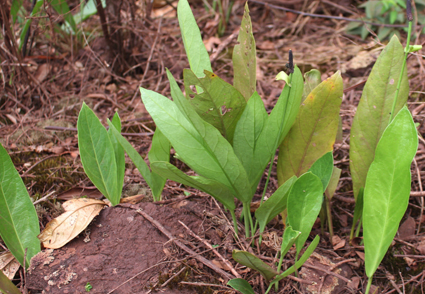Abstract
A new species of Anthurium section Pachyneurium, A. pedrovianae sp. nov. is described and occurs in canga vegetation of Serra dos Carajás, Pará State, Brazil. Information on conservation status, taxonomy, habitat, geographic distribution, and phenology is provided. Morphologically, the new species is similar to A.lindmanianum but differs from that species peduncle > 3 times the size of the petiole and a spadix < 6 cm long., stipe 6.0–11.0 cm long., purple at the base at the junction with the peduncle, berries are entirely purple, obovate, brown, warty seeds. Additionally, an identification key to distinguish the Pachyneurium species present in Pará is included.
References
- Bachman, S., Moat, J., Hill, A.W., Torre, J. & Scott, B. (2011) Supporting Red List threat assessments with GeoCAT: geospatial conservation assessment tool. ZooKeys 150: 117–126. https://doi.org/10.3897/zookeys.150.2109
- Beentje, H. (2020) The Kew Plant Glossary, an illustrated dictionary of plant terms. Second Edition. Kew Publishing. Royal Botanic Garden, Kew.
- Boyce, P.C. & Croat, T.B. (2011 onwards) The Überlist of Araceae, Totals for Published and Estimated Number of Species in Aroid Genera. [https://www.researchgate.net/publication/369741356_Uberlist_-_April_2023]
- Bunting, G.S. (1975) Anthurium bonplandii G.S. Bunting. Acta Botanica Venezuelica 10: 267–268.
- Camelo, M.C. (2022) Estudos taxonômicos de Anthurium seção Pachyneurium (Schott) Engl. (Araceae) no Brasil. Doctoral Thesis. Instituto de Pesquisas do Jardim Botânico do Rio de Janeiro, Escola Nacional de Botânica Tropical, Programa de Pós-graduação em Botânica, Rio de Janeiro, 224 pp.
- Carlsen, M.M. & Croat, T.B. (2013) A molecular phylogeny of the species-rich Neotropical genus Anthurium (Araceae) based on combined chloroplast and nuclear DNA. Systematic Botany 38: 576–588. https://doi.org/10.1600/036364413X670287
- Carlsen, M.M. & Croat, T.B. (2019) An analysis of the sectional classification of Anthurium (Araceae) comparing infrageneric groupings and their diagnostic morphology with a molecular phylogeny of the genus. Annals of the Missouri Botanical Garden 104: 69–82. https://doi.org/10.3417/2018215
- Coelho, M.A.N. (2018) Flora das cangas da Serra dos Carajás, Pará, Brasil: Araceae. Rodriguésia 69: 25–40. https://doi.org/10.1590/2175-7860201869103
- Croat, T.B. & Bunting, G.S. (1979) Standardization of Anthurium descriptions. Aroideana 2: 15–25.
- Croat, T.B. (1985) Collecting and preparing specimens of Araceae. Annals of Missouri Botanical Garden 72: 252–258. https://doi.org/10.2307/2399178
- Croat, T.B. (1988) Ecology and life forms of Araceae. Aroideana 11: 1–55.
- Croat, T.B. (1991) A revision of Anthurium section Pachyneurium (Araceae). Annals of the Missouri Botanical Garden. 76: 539–855. https://doi.org/10.2307/2399801
- Croat, T.B. & Carlsen, M.M. (2020) A new section of Anthurium: section Cordato-punctatum (Araceae), restricted to Central America. Novon 28: 46–50. https://doi.org/10.3417/2019370
- Dalzell, N.A. (1852) Contributions to the Botany of Western India. In: Hooker, W.J. (ed.) Hooker’s Journal of Botany and Kew Garden Miscellany. Vol. 4. Reeve, Bentham, and Reeve, London, pp. 289–295.
- Ellis, B., Daly, D.C., Hickey, L.J., Johnson, K.R., Mitchell, J.D., Wilf, P. & Wing, S.L. (2009) Manual of Leaf Architecture. The New York Botanical Garden, Cornell University. https://doi.org/10.1079/9781845935849.0000
- Engler, H.G.A. (1879) Araceae. In: De Candolle, A. & De Candolle, C. (eds.) Monographiae Phanerogamarum Prodomi. Vol. 2. C. Wolf & Fils, Munich, pp. 1–681.
- Engler, A.H.G. (1898) Beiträge zur Kenntnis der Araceae. VIII. Botanische Jahrbücher für Systematik, Pflanzengeschichte und Pflanzengeographie 25: 352–476.
- Engler, H.G.A. (1905) Araceae–Pothoideae. Das Pflanzenreich 4: 1–330.
- Flora e Funga do Brasil (2024) Jardim Botânico do Rio de Janeiro. Available at: http://floradobrasil.jbrj.gov.br/ (accessed: 29 February 2024)
- IBGE (2012) Manual técnico da vegetação brasileira: sistema fitogeográfico, inventário das formações florestais e campestres, técnicas e manejo de coleções botânicas, procedimentos para mapeamentos. Coordenação de Recursos Naturais e Estudos Ambientais. 2 ed., Rio de Janeiro, 276 pp.
- IUCN. (2023) The IUCN Red List of Threatened Species. Version 2023-1. Available at: https://www.iucnredlist.org. (accessed: 29 Feb 2024).
- Mayo, S.J., Bogner, J. & Boyce, P.C. (1997) The Genera of Araceae. Royal Botanic Gardens. The European Union by Continental Printing, Belgium.
- Martins, F.D., Carvalho, A.S. & Ribeiro, K.T. (2018) Inserção territorial e histórica da floresta nacional decarajás e sua relação com a mineração. In: Martins, F.D., Kamino, L.H.Y. & Ribeiro, K.T. (orgs.) Projeto Cenários: Conservação de Campos Ferruginosos diante da Mineração em Carajás. Tubarão: Copiart, pp. 21–38.
- Mota, N.F.O., Silva, L.V.C., Martins, F.D. & Viana, P.L. (2015) Vegetação sobre Sistemas Ferruginosos da Serra dos Carajás. In: Carmo, F.F. & Kamino, L.H.Y. (orgs.) Geossistemas Ferruginosos no Brasil. Instituto Prístino, Belo Horizonte, pp. 289–315.
- Poeppig, E.F. (1845) Nova Genera ac Species Plantarum, Anthurium kunthii Poepp. 3: 84–85.
- Secco, R.S. & Mesquita, A.L. (1983) Nota sobre a vegetação de canga da Serra Norte. Boletim do Museu Paraense Emílio Goeldi. Nova Série Botânica 59: 1–13. https://doi.org/10.46357/bcnaturaisnsbotanica.n59p1.13.1983
- Silva, M.F.F. (1991) Análise florística da vegetação que cresce sobre canga hematítica em Carajás—Pará (Brasil). Boletim do Museu Paraense Emilio Goeldi. Série Botânica 7: 79–108.
- Skirycz, A., Castilho, A., Chaparro, C., Carvalho, N., Tzotzos, G. & Siqueira, J.O. (2014) Canga biodiversity, a matter of mining. Frontiers in Plant Science 5: 653. https://doi.org/10.3389/fpls.2014.00653
- Schott, H.W. (1829) Wiener Zeitschrift für Kunst, Litteratur, Theater und Mode 100: 828.
- Schott, H.W. (1860) Prodromus Systematis Aroidearum. Typis Congregationis Mechitharisticae, Vindobonae, 602 pp.
- Thiers, B.M. (2024 [updated continuosly]) Index Herbariorum. [https://sweetgum.nybg.org/science/ih/]
- Viana, P.L., Mota, N.F. de O., Gil, A. dos S.B., Salino, A., Zappi, D.C., Harley, R.M., Ilkiu-Borges, A.L.,Secco, R. de S., Almeida, T.E.,Watanabe, M.T.C., Santos, J.U.M. dos, Trovó, M., Maurity, C. & Giulietti, A.M. (2016) Flora das cangas da Serra dos Carajás, Pará, Brasil: história, área de estudos e metodologia. Rodriguésia 67 (5spe): 1107–1124. https://doi.org/10.1590/2175-7860201667501
- Zappi, D.C., Moro, M.F., Meagher, T.R. & Lughadha, E.N. (2017) Plant biodiversity drivers in Brazilian campos rupestres: insights from phylogenetic structure. Frontiers in Plant Science 8: 2141. https://doi.org/10.3389/fpls.2017.02141
- Zappi, D.C., Moro, M.F., Walker, B., Meagher, T., Viana, P.L., Mota, N.F.O., Watanabe, M.T.C. & Lughadha, E.N. (2019) Plotting a future for Amazonian canga vegetation in a campo rupestre context. PLOS ONE 14: e0219753. https://doi.org/10.1371/journal.pone.0219753


